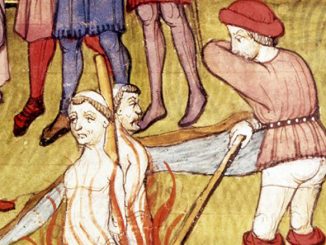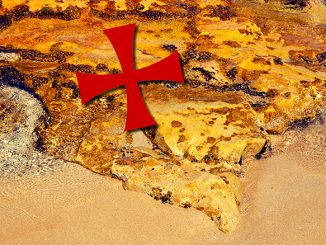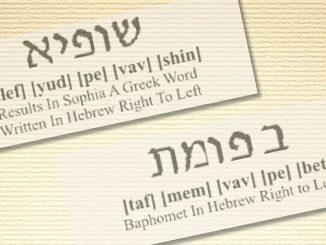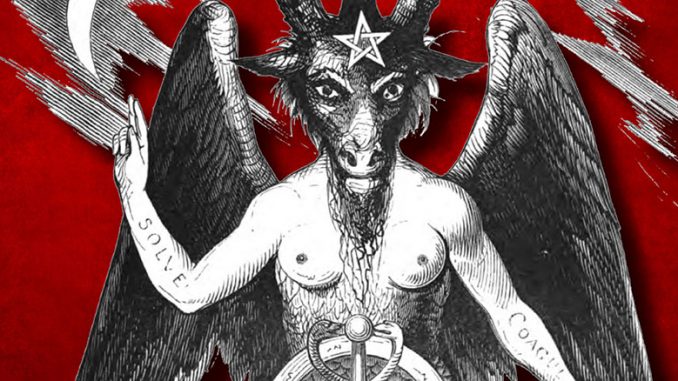
The Baphomet Enigma by Stephen Dafoe
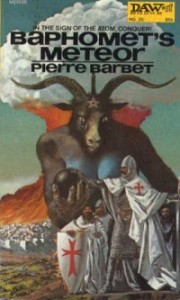 In his 1972 science fiction novel, Baphomet’s Meteor, French author Pierre Barbet crafts an entertaining story of alternative history about the Knights Templar and the demonic entity known as Baphomet. In the alternate dimension that is the province of Barbet’s book, Baphomet is a stranded extraterrestrial whose alliance with the Templars provides them with the scientific edge and atomic weaponry to create an empire in order to serve Baphomet’s outer-space motives.
In his 1972 science fiction novel, Baphomet’s Meteor, French author Pierre Barbet crafts an entertaining story of alternative history about the Knights Templar and the demonic entity known as Baphomet. In the alternate dimension that is the province of Barbet’s book, Baphomet is a stranded extraterrestrial whose alliance with the Templars provides them with the scientific edge and atomic weaponry to create an empire in order to serve Baphomet’s outer-space motives.
While it seems peculiar that the Templars would ever be involved with worshipping a cat, there are those who have offered that perhaps the Baphomet idol was a representation of the Egyptian cat goddesses Bast or Sekhmet. In reality the explanation of the cat worship accusation is far simpler. In Medieval times, those who the church wished to label as heretics were accused of using a witch’s familiar. This type of heretical belief began in the 12th century in the very same century that the Templars formed. Essentially a Witch’s familiar was, according to the church, the devil in animal form, usually a cat or goat. It was said that the devil would appear at the black masses of the witch’s held at midnight, and thus we return to a motivation behind accusation number eight – that the Templars held their meetings in secret and at night.
Since the worship of a cat or witch’s familiar is little more than a standard accusation of heresy, we can be certain that there is little of value in suggesting that it was the Baphomet enigma.
This leaves us with that portion of the accusation, which claims that the Templars worshipped an idol that was a head. Over the last few centuries, there have been many theories as to what this head may have been. Some of the theories are plausible while others are not as possible. What follows are some of the more popular notions as to what the head, if it existed, may have been.
Perhaps one of the most credible theories involves the Christian icon, known as the Shroud of Turin. It is generally accepted that the Templars were actively involved in the sac of Constantinople in 1204 and it has been said that they removed the Shroud at that time. When the shroud is folded in four it would depict the bearded head of a man, which fits with the description of the bearded head alleged to be the object of Templar devotions. Additionally one of the descriptions was an image with two heads and four feet. If one considers that the shroud, when laid open in its full form, depicts the front and back of Christ, then we can see that the description once again fits. In either case, if the Templar idol was the Shroud and the Shroud is the image of Christ, it could hardly be an image considered sinful. The interested reader would do well to read the article by John Ritchie, a Templar historian, from our fall 2001 issue for more info on the Shroud of Turin and the Mandylion.
But the head of Christ is not the only theory as to what the bearded head may have been. Some have put forth that it was none other than the severed head of John the Baptist. While this theory seems implausible at first glance, it should be pointed out that during the crusades, the trade in religious relics was as prevalent as the trading of baseball cards is today. It is generally accepted that there were several so-called John the Baptist heads circulating Christendom. What they were made of remains to be clearly explained, but it is possible that the Templars may have had one. Once again the herald of Christ could hardly be construed to have been anything of a sinister nature.
While both of the above theories have firm supporters and equally firm detractors, no trace of any such relic was found when the Templars were arrested throughout France and beyond. In fact, the only item found was a gilded head. This gilded head was the image of a woman and may well have been an image of the Virgin Mary, to whom all Templar preceptories and churches were dedicated.
Despite the lack of concrete evidence to support any such idol having ever existed, the accusations proceeded into trials and the trials into a verdict of guilty. As a result many Templars were burned at the stake as heretics including de Molay, the last Grand Master of the Order.
If then there is no evidence to finally solve what the idol was, perhaps we can shed some light onto the name itself. Baphomet’s etymology has caused as much confusion and controversy as the theories as to what it may have been in a tangible form.
The most plausible explanation for the word Baphomet is that it is either Old French for or a corruption of the name Mohammed. Mohammed or Mahomet (which shows the similarity in spelling) is the Prophet of Islam. To those who were charged with extracting confessions from the imprisoned Templars, the confession that the Templars had switched faiths to become Moslems would be as good as that of any guilty verdict. In those days to be a Moslem was to be an infidel and as such, to be in league with the devil. It cannot be argued that men under excruciating forms of torture would have confessed to nearly anything in order to free themselves from the pain of the heinous forms of punishment that were inflicted upon them.
But this theory as sensible as it is does nothing to support an idol. For in the Islamic faith, the worship of any idol is forbidden. We saw this in recent years with the destruction of centuries old Buddhist statues in Afghanistan, during the dark days of the Taliban regime. If the Templars had indeed adapted the beliefs of Islam, then an idol of the Prophet Mohammed would surely have been taboo.
Another theory along Islamic lines is that Baphomet is a corruption of the Arabic, Abufihamat, which means Father of Understanding or Father of Wisdom. It cannot be argued that many Templars spoke Arabic, for this was a necessity in order to deal with their enemies and to survive in the communities in which they had business dealings. Perhaps the Templars adapted this common Arabic word as a name for King Solomon, whose Temple was the basis of their name.
Dr. Hugh Schonfield, whose work on the Dead Sea Scrolls is well known, developed one of the more interesting theories. Schonfield who had studied a Jewish cipher called the Atbash cipher, which was used on some of the scrolls, claimed that when one applied the cipher to the word Baphomet, it transposed into the Greek word Sophia, which means knowledge, but also is the name of the goddess.
While this theory is controversial to many, it cannot be argued, by anyone familiar with the code, that Baphomet does create Sophia, at least phonetically. It is also known, as we covered earlier in this article that the one object found in Templar possession that could be deemed an idol was the gilded head of a woman.
It has long been the belief of Alan Butler and myself that the Templars, while Christian on the surface were dedicated to reuniting the feminine aspect of divinity with the Godhead. It is not at all surprising to note that the patron of the order, St. Bernard of Clairvaux was an absolute devotee to the Virgin Mary and was largely responsible for her present place of prominence within Catholicism. The Templars, as stated earlier, dedicated all of their properties to the Virgin Mary.
Perhaps the Schonfield theory of Sophia is much more than the simple Greek word for wisdom. If one looks at the Greek version of the Bible, Wisdom or Sophia is always spoken of in the feminine form. Could it be that to the Templars Baphomet or Sophia was akin to the divine Shekinah or Glory of God, that rested on the Mercy Seat of the Ark that resided in the Holy of Holies in Solomon’s Temple? We may never know the answer.
The nineteenth century occultist and author, Eliphas Levi, put forth the final theory we will look at in our examination of the etymology of Baphomet. According to Levi. Baphomet was a condensed version of a Latin phrase. To Levi the letters TEM OHP AB, which is Baphomet spelled backwards was the short form of “Templi Omnivm Hominum Pacis Abbas” This phrase translates in English as “The Father Of The Temple Of Peace Of All Men.” Eliphas Levi sincerely believed that this was an allusion to the Temple of Solomon, which he felt had the sole purpose of unifying all of mankind regardless of religious or political background.
While this is certainly a romantic notion and would lend credibility to a connection with the Templars, since they were in fact named for the Temple of Solomon, it is no more likely to be correct than any of the other theories presented in this article.
The simple fact of the matter is that we will probably never know the true enigma of the Baphomet, if it was anything more than a tool of the inquisitors to extract a verdict of guilty. A verdict that would allow those, with avarice eyes, to gain control of the wealth of the order.
However, Levi’s theory on the etymology of Baphomet, was not to be his sole contribution to the Baphomet mythos. In the latter part of the nineteenth century, he created an illustration of the Baphomet (accompanying this article) which would go forth as the definitive representation of the idol alleged to be worshipped by the order during their time in the Levant.
It is this image of Baphomet that inspired Arthur Edward Waite’s devil card in the Rider Waite Tarot and was the image “de jour” chosen by Karel Thole for his cover of Barbet’s novel Baphomet’s Meteor.
Levi’s Baphomet, while adopted by many Fundamentalists Christians, as the definitive representation of the devil is actually more a representation of Hermeticism than it is a representation of anything sinister, but symbols like art are in the eye of the beholder.
Contained within Levi’s Baphomet image are the dualistic attributes of life as well as the male and female aspects of creation. If one looks at the picture, one sees that one arm is masculine while the other is slender and feminine. The creature has the breasts of a female and a caduceus on the lap, which clearly represents the phallus. One arm points skyward, while the other points towards the earth. This is clearly a representation of the Hermetic axiom, “As above—So below.” The arms are also pointing to a dark moon and a crescent moon, perhaps alluding to the waxing and waning phases of the moon, but may well represent the dichotomy of good Vs evil. On the right arm is written “Solve” Solution and on the Left “Coagula” Coagulation. These are references found in alchemy, a study that Levi not only undertook but also wrote about in his books.
What troubles many people when they look at the image is the goat’s head with a pentagram on it. While the goat’s head can be easily connected to the witch’s familiar referred to in the earlier paragraphs of this article, it should be noted that the goat as a symbol of evil comes to us largely from the Scapegoat of Judaism. During the days of atonement the priest would cast lots over two goats. One would be sacrificed to YHVH, while the other would be sent into the woods to be with the devil, carrying the sins of the people with him.
Much ado has been made over the years about the five-pointed star and witchcraft. It should be noted that at one time the point up star represented the five wounds of Christ suffered on the cross, when He, like the scapegoat of Judaism, carried the sins of mankind away with His crucifixion.
But my interpretation of Levi’s sketch is as much open to error as anyone’s. What remains important is what the author had to say about it himself. The following is the preface to his book, “Dogma Et Rituel Haute Magie” published in 1861:
“The goat on the frontispiece carries the sign of the pentagram on the forehead, with one point at the top, a symbol of light, his two hands forming the sign of Hermeticism, the one pointing up to the white moon of Chesed, the other pointing down to the black one of Geburah. This sign expresses the perfect harmony of mercy with justice. His one arm is female, the other male like the ones of the androgyn of Khunrath, the attributes of which we had to unite with those of our goat because he is one and the same symbol. The flame of intelligence shining between his horns is the magic light of the universal balance, the image of the soul elevated above matter, as the flame, whilst being tied to matter, shines above it. The ugly beast’s head expresses the horror of the sinner, whose materially acting, solely responsible part has to bear the punishment exclusively; because the soul is insensitive according to its nature and can only suffer when it materializes. The rod standing instead of genitals symbolizes eternal life, the body covered with scales the water, the semi- circle above it the atmosphere, the feathers following above the volatile. Humanity is represented by the two breasts and the androgyn arms of this sphinx of the occult sciences.”
As can be seen in his explanation of the drawing, there is no reference to the Templars to be found. Yet to this day many Fundamentalist Christians, most notably Jack T. Chick, author of The Curse of the Baphomet, have used the Levi image to bear false witness against the Templars and Freemasons of the world and in so doing break the very tenets of the faith. A faith that the Templars were sworn to defend.
At the end of the day we know no more about the Baphomet enigma than we did when the first Templar mouthed it under the crack of the inquisitors whip so many centuries ago. Perhaps we never will or perhaps someday some scholar will uncover this long-standing enigma at long last. For now we are left with a handful of theories as to the origins of the Baphomet, if it ever truly existed. Some of these theories are plausible and have found much credibility among Templars, while others remain as far-fetched as the science fiction of Pierre Barbet. I can only wonder which publisher will be the first to use Barbet’s book as a basis for another theory on the matter?
Clearly the book is intended as a work of fiction, but Barbet’s notion is no more far-fetched than some of the conspiracy theories that have been put forth in mainstream Templar literature over the last century and a half. Theories ranging from the Baphomet being a magical alchemy machine to the severed and mummified head of Jesus Christ.
While Baphomet’s Meteor is an entertaining afternoon’s read for any science fiction fan or Templar aficionado, it does perpetuate the long-standing myths that have haunted Templarism since the arrests in the fall of 1307. Chiefly that Baphomet was a demon worshipped by the order in secret meetings.
What is interesting about Baphomet’s Meteor is the cover illustration by Karel Thole. Thole was a prominent and prolific illustrator whose art graced the covers of science fiction novels by authors of greater renown than Barbet. A. E. Van Vogt, Isaac Asimov and many other patriarchs of the genre used Thole’s art on the covers of their novels. The cover of Baphomet’s Meteor shown with this article depicts a group of Templars in front of Thole’s illustration of Baphomet. It is evident, to anyone familiar with the Baphomet mythos, that Karel Thole’s inspiration for the image was the Baphomet created by the occultist Eliphas Levi. We will return to Levi and his contribution to the Baphomet enigma later in this piece, but suffice to say that groups who are at opposite ends of the pole have adopted the Levi image. Levi’s Baphomet has been used on everything from T-shirts bought at Heavy Metal concerts to Bible tracts used to slander the Masonic and Templar fraternities.
But what is Baphomet, and from whence does the word derive?
As readers of this magazine are aware, the Templars were arrested on October 13th, 1307 under charges of heresy. These charges, as trumped up as they were, fell into nine essential categories.
1/ that during the reception ceremony, new brothers were required to deny Christ, God, the Virgin or the Saints on the command of those receiving them.
2/ that the brothers committed various sacrilegious acts either on the cross or on an image of Christ.
3/ that the receptors practiced obscene kisses on new entrants, on the mouth, navel or buttocks.
4/ that the priests of the Order did not consecrate the host, and that the brothers did not believe in the sacraments.
5/ that the brothers practiced idol worship of a cat or a head.
6/ that the brothers encouraged and permitted the practice of sodomy.
7/ that the Grand Master, or other officials, absolved fellow Templars from their sins.
8/ that the Templars held their reception ceremonies and chapter meetings in secret and at night.
9/ that the Templars abused the duties of charity and hospitality and used illegal means to acquire property and increase their wealth.
While these accusations and charges are familiar to most of us, it is important to note that nowhere among them is found the word Baphomet. In fact for anyone who has studied the transcripts of the trials that commenced in 1308, actual references to the Baphomet are but few.
It is not the province of this brief account of the Baphomet to go into detail of the majority of the charges. For the reader interested in the accusations of denying and spitting on the cross, you may wish to read the article, “Did the Pope Pardon the Templars?” found in this issue of Templar History Magazine.
What is important to our examination of the charges is article number 5:
5/ that the brothers practiced idol worship of a cat or a head.
In my 1998 book, Unholy Worship – the myth of the Baphomet Templar, Freemason connection, I examined the history of the Templars and the accusations of heresy that led to their ultimate demise. In the book I stated that these charges were nothing new and certainly far from unique. Similar charges had been leveled against the Cathars of Albi during the Albigensian Crusades and had continued on down to the charges against the so-called witches of Salem Massachusetts in the New World.
What is ironic is that the church accused the Templars of worshipping idols, but that very same church was rife with idolatry if one considers the many statues of saints that were a focus of daily Christian devotion. No matter at all, for the Templars were the victims of the classic, “either you are with us or against us” and as certain ecclesiastical and secular authorities wished the Templar wealth for their own, the charges were levied.
About Us
We hope you enjoyed this article on the Baphomet Enigma.
TemplarHistory.com was started in the fall of 1997 by Stephen Dafoe, a Canadian author who has written several books on the Templars and related subjects.
Read more from our Templar Mysteries Archives – Templar History

